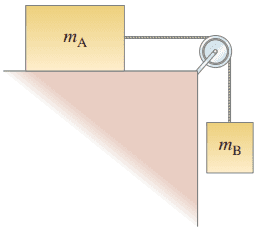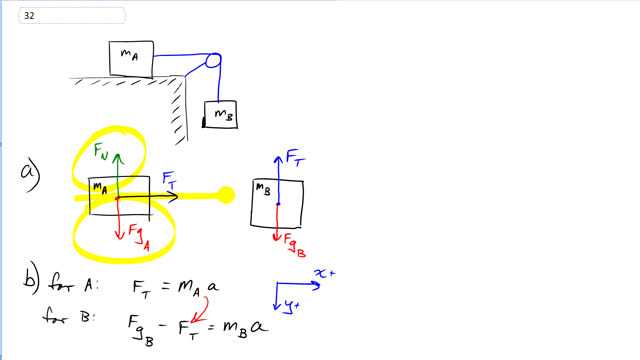
Figure 4–53 shows a block (mass ) on a smooth horizontal surface, connected by a thin cord that passes over a pulley to a second block () which hangs vertically.
- Draw a free-body diagram for each block, showing the force of gravity on each, the force (tension) exerted by the cord, and any normal force.
- Apply Newton’s second law to find formulas for the acceleration of the system and for the tension in the cord. Ignore friction and the masses of the pulley and cord.

- see video

In order to watch this solution you need to have a subscription.
This is Giancoli Answers with Mr. Dychko. Block A has a normal force upwards equal to the force of gravity downwards on it and there is a tension force pulling it to the right due to the cord and this mass B is resulting in a tension in the cord. For mass B the tension is going upwards and the force of gravity is going downwards. And I suppose I should really have this arrow a bit longer because it's going to be falling, accelerating downwards I should say. Now to calculate the acceleration first we'll say that the tension force is mass A times its acceleration. And then consider Block B the... Considering down to be the positive direction by the way. So, that means we have Fg on Block B downwards minus the tension up equals mass, p, times its acceleration. So, this is the net force on block B equals the mass of B times its acceleration. And I have no subscript b on this and no subscript a on the acceleration because the acceleration of both blocks will have the same magnitudes. So, that's nice. So, we're noticing that by not having a subscript on them. So, we can make some substitutions into this formula for the net force equals mA on block B. So, we have FgB minus the force of tension and we're substituting FT equals mA times acceleration equals mB times a, just copied here. And then force of gravity on block B is block B’s mass times g minus mA times acceleration equals mB times a. And then move this term to the right hand side and then switch the sides around, we're collecting the a terms together because we want to solve for acceleration. And here we have this line next and then we can factor out the common factor a and then that becomes a times mass A plus mass B equals g times mass B, and then divide both sides by this bracket. And we have acceleration is g times mass B divided by mA plus mB. And when you get a formula like this, it's always nice to do a little reality check on the question to see if this makes sense. So, it doesn't make sense to have acceleration increasing with mass B as would be the case if this is the correct formula. And sure enough if, you know, it makes sense if this is a really heavy mass then it'll accelerate down more. And mass A appears in the denominator of this formula. So, should the acceleration... Should it decrease with an increase in mass A, and that's what this formula says. And sure enough if this was a big one, a big mass there then you'd expect the acceleration to decrease. So, that's the sort of thing you should always do at the end of a question is a bit of a reality check. Now, the way I did it isn't.. And often this is the case, it isn't precisely correct, it's just sort of, does it work with your intuition. I mean, strictly speaking, as mass B increases, it won't always be the case that acceleration increases. Eventually when mass B becomes really, really, really big, this will actually converge to just being equal to g, because as mass B is really, really big mass, a becomes irrelevant, and then the expression becomes g times mass B over mass B, and if mass B is so big the mass A is negligible, you have this and then mass B's cancel and it converges to g. So, it isn't strictly true that the acceleration always increases as mass B increases, acceleration will converge towards its maximum of g freefall acceleration as mass B increases. Anyway. The tension force is mass A times the acceleration of block A as we saw here. And so, just multiply this expression by mA and there we have the tension force.
At the beginning of Part B (0:50 mark) you mentioned that positive y is in the down direction. When setting up the solution, how did you know/ why did you decide to make the positive y going downwards?
Thank you!
Hi sarahailu610,
Sorry for taking so long to get back. You've asked a good question. Deciding on which direction is positive is a matter of convenience or personal preference. In this case I chose down to be positive because that would make the acceleration of the falling block have the same sign as the acceleration of the sliding block . Since we know the blocks will have the same magnitude of acceleration since they're connected by the rope, the fact that they also have the same sign of their acceleration meant that I could simplify the algebra a little bit by denoting the acceleration of each block with the same variable . If the accelerations had different signs (by choosing the conventional "up" as positive) I would have had to denote the acceleration of block A as and that of block B as , and then establish that , and then substitute that into the equations... and this is not less correct, but just a little bit of messiness I could avoid by choose down as positive in this case.
All the best,
Mr. Dychko
but i got a different value when I chose to use y as negative . what can I do about it ? are both yours and mine correct ?
Hi zzdawit, choosing y as negative is a valid thing to do, but it should lead to the same answer. You have to take care that you distinguish between the acceleration of the two blocks. The accelerations are not the same anymore. They have opposite signs, and I would guess that you might consider carefully examining your work to see that you took their opposite signs into account. My comment above explains a bit more about this, but let me know if you have more questions.
All the best,
Mr. Dychko